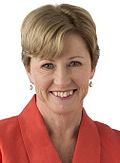There are Leaders of the Australian Greens (Greens) at the federal level, as well as in the several member parties which make up the confederation of the Australian Greens.
Contents
- Background
- Federal parliamentary leaders
- Federal deputy parliamentary leaders
- Leaders in the Senate
- Deputy Leaders in the Senate
- Member party leaders
- Australian Capital Territory
- New South Wales
- Northern Territory
- Queensland
- South Australia
- Tasmania
- Victoria
- Western Australia
- See also
- References














